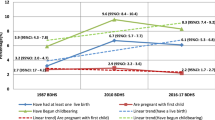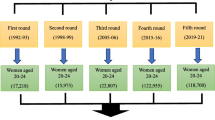Abstract
Objectives To examine levels, trends and correlates of childbearing in childhood (CiC) in the Rufiji district of Tanzania from 2002 to 2010. Methods Using longitudinal data collected in, and by, the Rufiji health and demographic surveillance system in Tanzania from 2002 to 2010, all women who initiated childbearing in this period (n = 5491) were selected for analysis. CiC was defined as childbearing initiation before age 18. Data analysis involved one–way tabulations of each variable—most of which were socio-demographic—to obtain frequency distributions, cross-tabulations of CiC and each of the independent variables with a Chi square test for associations, and multivariate analysis using multilevel logistic regression to examine covariates of CiC. Results CiC was 44 % and remained constant over the 2002–2010 period (P = 0.623). The relative odds of CiC was significantly reduced by 83 percent among women with secondary or higher educational attainment relative to CiC among uneducated women (OR = 0.17, CI 0.12–0.23). Moreover, the odds of CiC significantly declines monotonically as relative household wealth increases by quintile (OR = 0.70, CI 0.57–0.86). CiC also declines significantly with employment and marital status of the respondent. Conclusions CiC represents a challenging social and health problem. Forty-four percent of first time mothers in Rufiji district of Tanzania are of childhood age, and this has not changed over the past 9 years since 2002. Prioritizing girls’ formal education—especially up to secondary level or higher—as well as devising some economic empowerment modalities, may be worthwhile measures towards curbing CiC in the study area.


Similar content being viewed by others
References
Lee, D. (2005). The early socioeconomic effects of teenage childbearing: A propensity score matching approach. Demographic Research, 23, 697–736.
An, C.-B., Haveman, R., & Wolfe, B. (1993). Teen out-of-wedlock births and welfare receipt: The role of childhood events and economic circumstances. Review of Economics and Statistics, 75(2), 195–208.
Hofferth, S. L., Reid, L., & Mott, F. L. (2001). The effects of early childbearing on schooling over time. Family Planning Perspectives, 33(5), 259–267.
Jewkes, R., Morrell, R., & Christofides, N. (2009). Empowering teenagers to prevent pregnancy: Lessons from South Africa. Culture, Health & Sexuality, 1(7), 675–688.
Magadi, M., & Agwanda, A. O. (2009). Determinants of transitions for first sexual intercourse, marriage and pregnancy among female adolescents: Evidence from south Nyanza, Kenya. Journal of Biosocial Medicine, 41(3), 409–427.
Kongnyuy, E. J., Mlava, G., & van den Broek, N. R. (2009). Facility-based maternal death review in three districts in the central region of Malawi: An analysis of causes and characteristics of maternal deaths. Women’s Health, 19(1), 14–20.
Daulaire, N., Leidl, P., & Mackin, Lea. (2002). Promises to keep: The toll of unintended pregnancies on women’s lives in the developing world. Washington, DC: Global Health Council.
TDHS. (2011). Tanzania demographic and health survey 2010. Dar es Salaam: NBS, ICF Macro.
Gipson, J. D., Koenig, M. A., & Hindin, M. J. (2008). The effects of unintended pregnancy on infant, child, and parental health: A review of the literature. Studies in Family Planning, 39, 18–38.
Sedgh, G., Bankole, A., Oye-Adeniran, B., Adewole, I. F., Singh, S., & Hussain, R. (2006). Unwanted pregnancy and associated factors among Nigerian Women. International Family Planning Perspectives, 32, 175–184.
Woog, V., & Pembe, A. B. (2013). Unsafe abortion in Tanzania: A review of the evidence. http://www.guttmacher.org/pubs/IB_unsafe-abortion-tanzania.pdf.
WHO. (2012). Adolescent pregnancy. Fact sheet No. 364 (serial on the Internet). http://www.who.int/mediacentre/factsheets/fs364/en/.
WHO. (2008). Unsafe abortion: Global and regional estimates of the incidence of unsafe abortion and associated mortality in 2008. Geneva, Switzerland: World Health Organization.
UN. (1995). Tabulation of age specific rates, 1990–2045; The sex and age distribution of the world populations: The 1994 revision. New York: United Nations.
Makiwane, M. B. (1998). Adolescent pregnancy and reproductive health in Transkei (rural South Africa). African Journal of Reproductive Health, 2, 41–48.
Senanayake, P., & Ladjali, M. (1994). Adolescent health: Changing needs. International Journal of Gynaecology and Obstetrics, 46, 137–143.
Leshabari, M. T., Kaaya, S., & Kawau, F. (1997). Reproductive knowledge, premarital sex and other problem behaviour among school youth in Rombo District, Kilimanjaro region, Tanzania. Nairobi, Kenya: Ford Foundation.
Leshabari, M. T., Mpangile, G. S., Kaaya, S. F., & Kihwele, D. J. (1994). From teenage unwanted pregnancy to induced abortion: Who facilitates links? International Journal of Adolescence and Youth, 4, 195–210.
Mpangile, G. S., Leshabari, M. T., & Kihwele, D. J. (1993). Factors associated with induced abortion in public hospitals in Dar es Salaam. Reproductive Health Matters, 2, 21–31.
ADAM. (2011). Adolescent pregnancy. http://www.ncbi.nlm.nih.gov/pubmedhealth/PMH0002484/.
McCleary-Sills, S., Douglas, Z., Rwehumbiza, A., Hamisi, A., & Mabala, R. (2013). Gendered norms, sexual exploitation and adolescent pregnancy in rural Tanzania. Reproductive Health Matters, 21(41), 97–105.
Biddlecom, A. E., Hessburg, L., Singh, S., Bankole, A., & Darabi, L. (2007). Protecting the next generation in sub-Saharan Africa: Learning from adolescents to prevent HIV and unintended pregnancy. New York: Guttmacher Institute.
Fleischman, J. A. (2003). Suffering in silence: human rights abuses and HIV transmission to girls in Zambia (29 May 2013). http://www.hrw.org/sites/default/files/reports/zambia1202.pdf.
Glynn, J. R., Caraël, M., Auvert, B., Kahindo, M., Chege, J., Musonda, R., et al. (2001). Why do young women have a much higher prevalence of HIV than young men? AIDS, 15(Suppl 4), S51–S60.
Underwood, C., Skinner, J., Osman, N., & Schwandt, H. (2011). Structural determinants of adolescent girls’ vulnerability to HIV: Views from community members in Botswana, Malawi, and Mozambique. Social Science and Medicine, 73(2), 343–350.
Mwageni, E., Momburi, D., Juma, Z., Irema, M., Masanja, H., & Rufiji DSS. (1998). Tanzania essential health interventions project. Adult morbidity and mortality. Dar es Salaam, Tanzania: Tanzania Ministry of Health.
Mrema, S., Shamte, A., Selemani, M., & Masanja, H. (1906). The influence of weather on mortality in rural Tanzania: A time-series analysis. Global Health Action, 2012(5), 1999–20108.
Mrema, S., Kante, A. M., Levira, F., Mono, A., Irema, K., de Savigny, D., et al. (2015). Health and demographic surveillance system profile: The Rufiji health and demographic surveillance system (Rufiji HDSS). International Journal of Epidemiology, 44(2), 472–483.
Geubbels, E., Amri, S., Levira, F., Schellenberg, J., & Masanja, H. (2015). R. N. health and demographic surveillance system profile: The Ifakara rural and urban health and demographic surveillance system (Ifakara HDSS). International Journal of Epidemiology, 44(3), 848–861.
Phillips, J. F. (2003). Demographic surveillance systems. The Encyclopedia of Population, 1, 204–206.
Ye, Y., Wamukoya, M., Ezeh, A., Emina, J. B. O., & Sankoh, O. (2012). Health and demographic surveillance systems: A step towards full civil registration and vital statistics system in sub-Sahara Africa? BMC Public Health, 12, 741.
Filmer, D., & Pritchett, L. (1999). The effect of household wealth on educational attainment: evidence from 35 countries. Population and Development Review, 25(1), 85–120.
Vyas, S., & Kumaranayake, L. (2006). Constructing socio-economic status indices: How to use principal components analysis. Health Policy and Planning, 21, 459–468.
Kapoka, P. (1999). Literature review on adolescent reproductive health studies conducted in Tanzania 1988–1998. Institute of Development Studies (IDS): Dar-es-salaam, Tanzania.
Exavery, A., Kanté, A. M., Jackson, E., Noronha, J., Sikustahili, G., Tani, K., et al. (2012). Role of condom negotiation on condom use among women of reproductive age in three districts in Tanzania. BMC Public Health, 12, 1097.
Luke, N. (2003). Age and economic asymmetries in the sexual relationships of adolescent girls in sub-Saharan Africa. Studies in Family Planning, 34, 67–86.
Wamoyi, J., Wight, D., Plummer, M., Mshana, G. H., & Ross, D. (2010). Transactional sex amongst young people in rural northern Tanzania: An ethnography of young women’s motivations and negotiation. Reproductive Health, 7(1), 2.
Wamoyi, J., Fenwick, A., Urassa, M., Zaba, B., & Stones, W. (2011). “Women’s bodies are shops”: Beliefs about transactional sex and implications for understanding gender power and HIV prevention in Tanzania. Archives of Sexual Behavior, 40(1), 5–15.
UNICEF. (2012). UN Women and UNFPA focus on ending child marriage on the International Day of the Girl Child (5 June 2014). http://www.unicef.org/tanzania/7162_11954.html.
Acknowledgments
The authors are very thankful to the organizers and facilitators of the Mixed Methods Research and Publication Workshop which was held from 2nd to 6th June 2014 at Traveler’s Lodge in Bagamoyo, Tanzania where the idea was developed into a full draft. Elizabeth Jackson of the Mailman School of Public Health, Columbia University, is especially acknowledged for editing an early version of the manuscript. I extend my sincere appreciations to my fellow participants of the workshop for their presence and support—Kassimu Tani, Farida Hassan, Rose Kalage, Gloria Sikustahili, Hildegalda Prosper Mushi and the entire team. We extend special gratitude to Mallory C. Sheff of the Mailman School of Public Health, Columbia University for proofreading this manuscript. The workshop was made possible through funds from the Doris Duke Charitable Foundation (DDCF). The Rufiji HDSS is an active member of the INDEPTH Network.
Author information
Authors and Affiliations
Corresponding author
Rights and permissions
About this article
Cite this article
Exavery, A., Kanté, A.M., Mrema, S. et al. Multilevel Analysis of Childbearing in Childhood in Tanzania’s Rufiji District. Matern Child Health J 20, 447–455 (2016). https://doi.org/10.1007/s10995-015-1842-7
Published:
Issue Date:
DOI: https://doi.org/10.1007/s10995-015-1842-7




